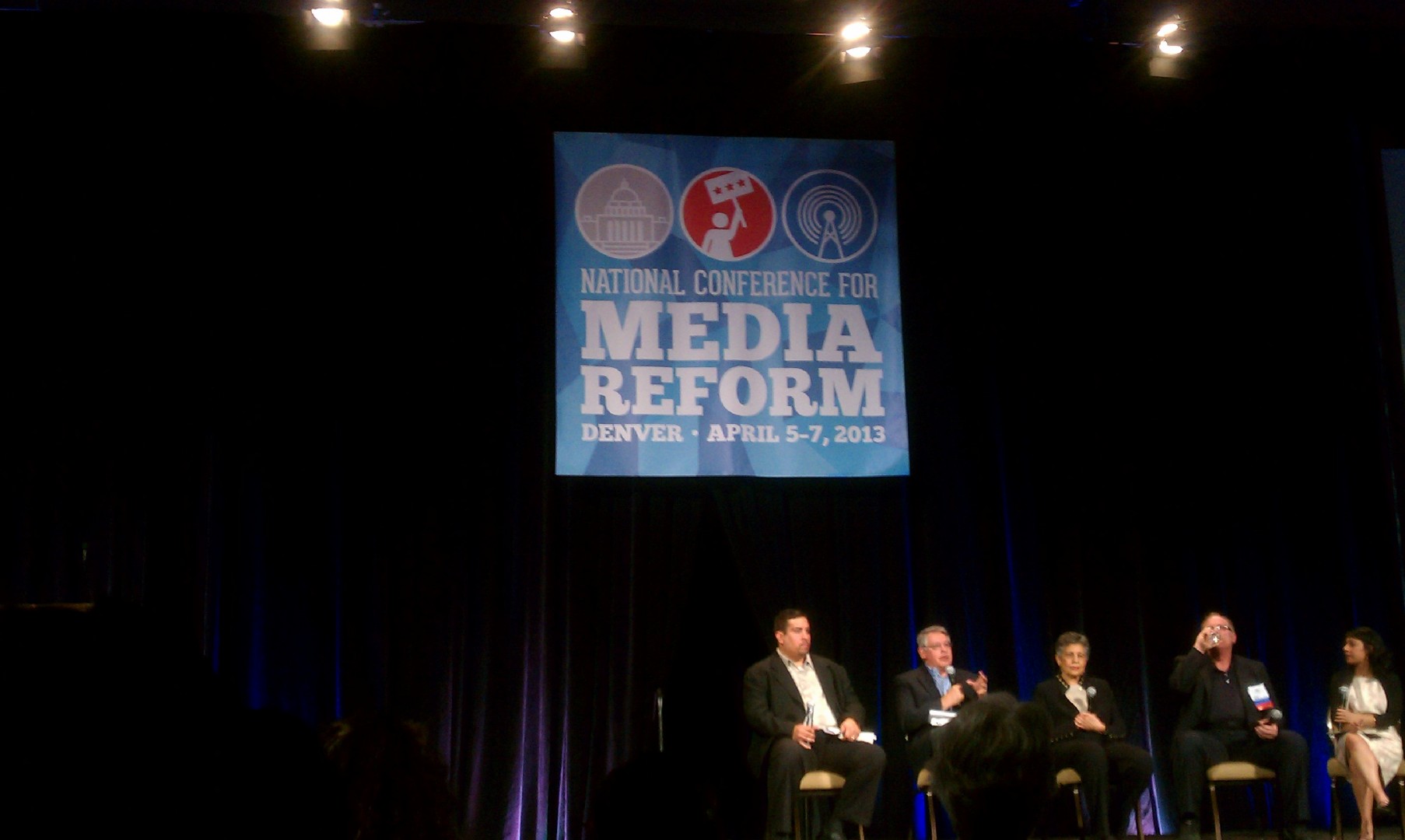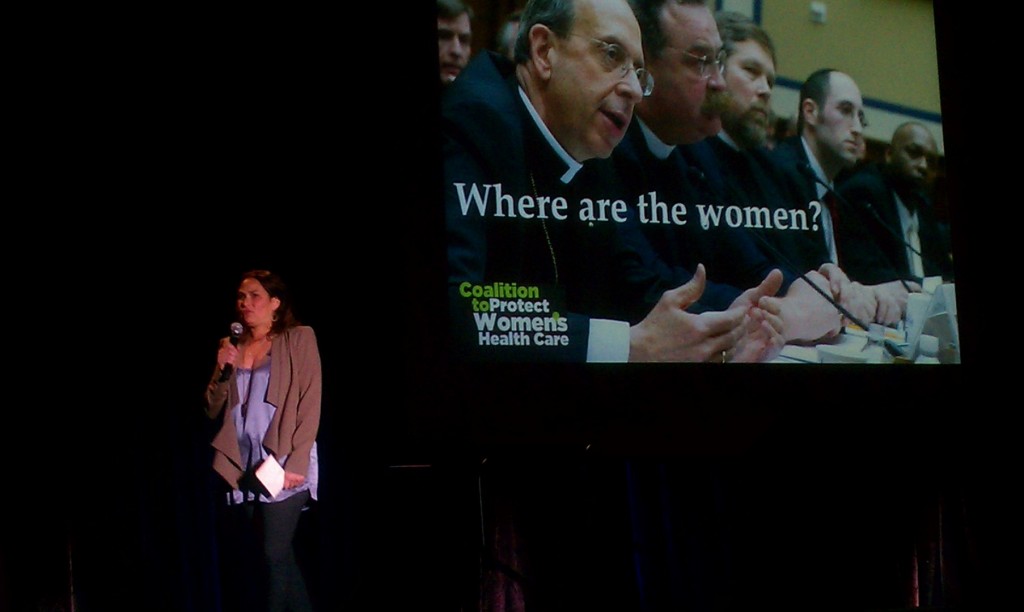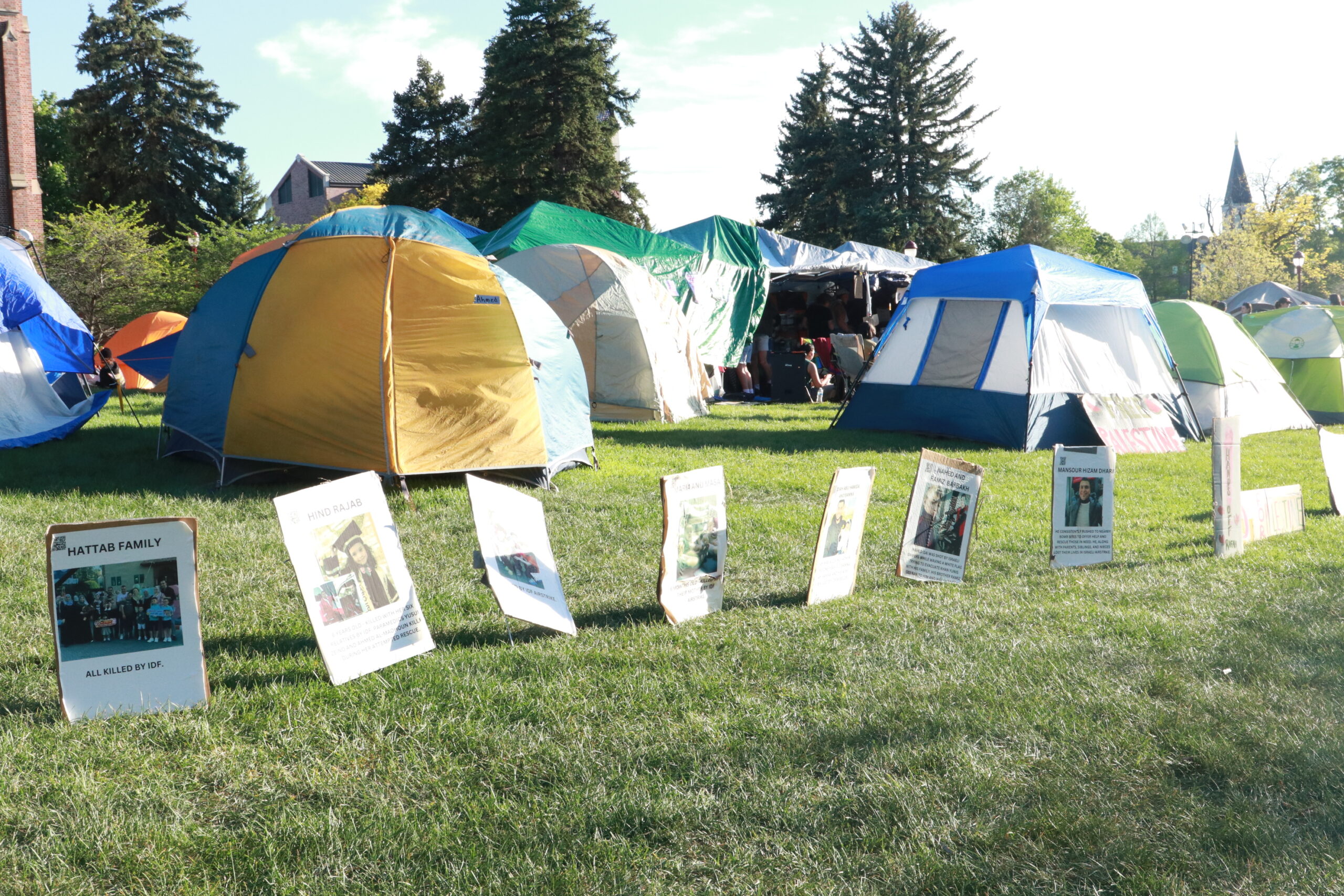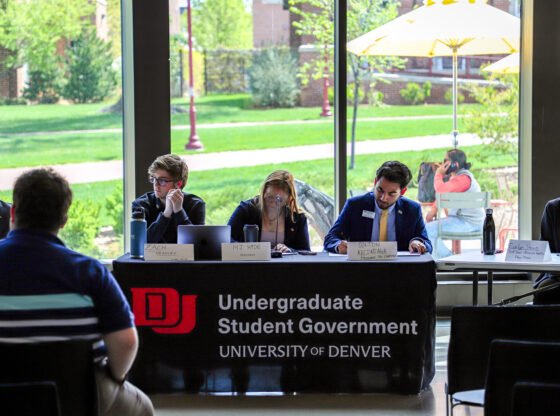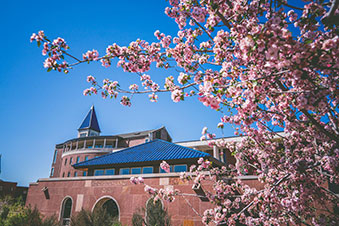Sunday, April 7, 2013 12:30 pm
Manufacturing Terror: The Media’s Anti-Arab and Anti-Muslim Problem
On Sunday morning, Adel Iskandar of Georgetown University, Mike German of the American Civil Liberties Union, Maytha Alhassen of the University of Southern California and Ahmed Shihab-Eldin of HuffPost Live and co-author of the book Demanding Dignity: Young Voices From the Front Lines of the Arab Revolution along with Alhassen spoke about the depiction of Arab and Muslim communities in the media.
The session was moderated by Suzanne Manneh of New American Media.
The events on Sept. 11, 2001 shaped the United States and the way in which its citizens interacted with the Arab world, according to German.
“After 9/11 when there was this surge in studying terror, the government went after the political side,” German said. “If the issue is there is a defect in these people, you don’t have to look at your country and your own policy.”
In particular, what the government and law enforcement were and still are most concerned with is the escalation of perceived extremism in Arab or Muslin communities.
“The most dangerous was the idea of radicalization,” German said. “The FBI came up with a four step process of how somebody moves from normal, productive citizen to terrorist.”
The brief process delineated by the FBI document described how an individual moves from one stage to another.
“First, in individual adopts an ideology, then they become an activist on behalf of the ideology and then become a terrorist,” German said. “If they answer in a pro-Western, patriotic way could be used as an informant. If they don’t, there is a possibility they are militant.”
This procedure, according to German, lacks essential evidence.
“There is zero empirical evidence supporting it,” German said. “And it makes it very simple for the government to justify surveilling the people who have a particular ideology.”
Baseless as these tactics may be, they were still circulated amongst law enforcement officials nationwide.
“The NYPD spying on Muslims is reaction to the theory presented in ‘From Conversion to Jihad,’” German said. “The FBI was putting on this racist training for state and local law enforcement and their own agents from 2003 until 2011. A decade’s worth of law enforcement agents were being trained with this racist material.”
Shihab-Eldin emphasized that this institutionalized prejudice is still an integral part of the way in which the United States operates currently.
“We often talk about how we failed in the lead up to the Iraq war,” Shihab-Eldin said. “But there was also a decade long war that continues arguably to this day where we are failing.”
The narrative, according to Shihab-Eldin is limited and excludes pivotal voices and stories from mainstream coverage.
“There’s so much that isn’t being told, the true human cost of the Iraq people, the drone attacks, because we use this anti-terrorism language,” Shihab-Eldin said.
This language, according to Alhassen, has been present for decades and has been influencing how Arab and Muslim groups are understood for just as long.
“The strange thing that Arabs know that a lot of other people don’t is that we’ve lived with this for years,” Alhassen said.
“The strange thing that Arabs know that a lot of other people don’t is that we’ve lived with this for years,” Alhassen said. “’Where they cut off your ear/ If they don’t like your face/ It’s barbaric, but hey, it’s home. Does anyone know where that’s from? It’s from Disney’s ‘Aladdin.’”
The influence of media, according to Shihab-Eldin, could not be overstated.
“The perception of our community, of people who are Arab or Muslim, is literally a product of the way media receives the government’s attitude towards Arabs and Muslims and people in the Arab world,” Shihab-Eldin said.
And, according to German, vocabulary and rhetoric utilized by media outlets have a deep impact in justifying government actions with regards to the Arab world.
“Every time you use the word ‘radicalization,’” German said, “it justifies spying on a community as a whole.”
A general apathy surrounding the oversights of the media, according to Iskandar, is used as justification for warping the realities of Arab and Muslim communities in the United States.
“There is a perception by commercial media that the American public doesn’t care when Arab and Muslim-Americans are dehumanized,” Iskandar said. “They are prepared to forego the basic rights for a group of Americans that we expect for all other citizens.”
The panel said that changing these socio-cultural institutions that propagate ignorance begins with refocusing efforts on reporting the truth of Arab and Muslim groups.
“The remedy is not to say, ‘let’s try to portray a sympathetic depiction of Arabs or Muslims.’ It’s going to be warped and amputate some part of reality,”Iskandar said. “Pigeon-holing us is in and of itself problematic.”
Central to that, according to Iskandar, is an engaged relationship between the public and the media.
“Continue to critique corporate media, push from the margins and advocate that media provide a platform so people can speak for themselves,” Iskandar said.
Additionally, education is a critical component when moving forward, according to Alhassen.
“Look up state standards for K-12 education,” Alhassen said, “And look at the materials included on Arabs or the Israeli-Palestinian conflict. The material is often one-sided and because teachers uninformed on these topics, they depend on state curriculum.”
And, according to Iskandar, when creating a platform for someone to tell their story, it is essential that the space not be restricted or interfered with.
“Something could be done on the curricular level,” Iskandar said. “Something like an Arab-awareness month or a Muslim-awareness month. Often Muslim communities brought to speak are forced to depoliticize. When learning someone else’s history, it becomes key to contextualized and historicize.”
Saturday, April 6, 2013 10:22 pm
Saturday, April 6, 2013 8:32 pm
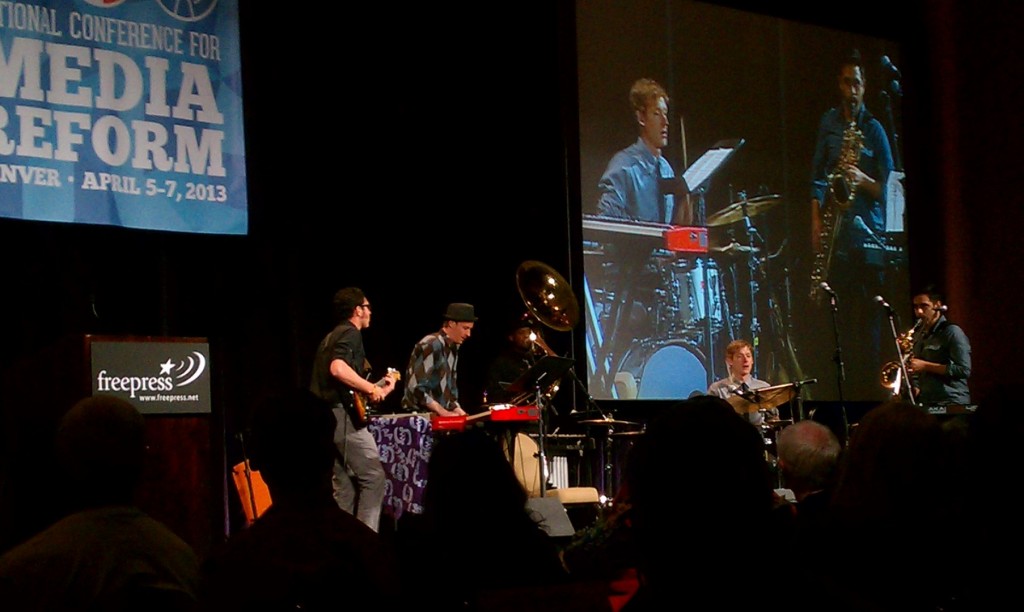

Saturday, April 6, 2013 6:19 pm
Covering Race in the Time of Obama
Davey D, hip-hop historian and Hark Knock Radio host, Eric Deggans of the Tampa Bay Times, Achy Obejas of In These Times and Rinku Sen of Applied Research Center and Colorlines.com shared the stage today to discuss covering race in the time of Obama. The session was moderated by Laura Washington, a journalist, commentator and editor.
“The election of President Obama, that very event, opened up a bunch of space and interest in the media,” Sen said.
The panel discussed both the advantages and disadvantages of the unprecedented access to information and communication potential in the digital age.
“Even though in 2013 we have a plethora of media outlets, and we can find just about any topic under the sun, what has happened is that people have lost focus and they’re no longer thinking critically,” D said. What becomes important, according to D, is no longer the news itself, but the way it is presented.
“It becomes a dependent on personality–you make it sound good or saucy or sexy, and that overshadows the actual content,” D said.
Obejas approached the polyphonic nature of the internet from another angle, focusing on the pitfalls of immediate contact.
“People who are completely out of their minds also find each other and perpetuate a series of false facts,” Obejas said. “It’s one of those cases where you can drop something idiotic, frame it as a statistic and that thing takes off like prairie fire. As a journalist you’re battling this tremendous ignorance.”
This ignorance, according to Sen, is partially created by a society that restricts the definition of racism to very particular characteristics.
“The way in which racism is defined is based on individual intentional and overt action,” Sen said. “The structural level, where different institutions interact with each other in either compounding or reducing racism, is left out of the conversation.”
False equivalencies especially, according to Sen, are symptoms of a narrow definition of racism.
Sen gave an example of an encounter she had last week while visiting the Penn State campus to discuss race and media with staff, faculty and students.
“Last week I gave two talks at Penn state,” Sen said. “At the first talk, one person came at first talk. At the second, eight to ten of the regular crowd I attract came and additionally 150 white male frat members were there. They came because it’s the end of the year and they had to fulfill diversity education requirement.”
Sen decided to abandon the material she typically lectures on in favor of a conversation with her unconventional audience in an attempt to better connect with them.
“They said that they face stereotypes too,” Sen said. “They told me that they hide the fact that I’m in a frat when they go out because they face discrimination. Their message of ‘you experience racial stereotyping, I experience frat stereotyping is a false equivalency.”
According to Sen, this exchange was a clear example of the way in which race issues are misunderstood in many communities.
“Things like this hold up the America public’s ability to solve racial problems because we don’t understand them properly,” Sen said.
One of the reasons Americans lack an understanding of matters like this, according to Obejas, is because of the absence of critical coverage of racial issues by a media who doesn’t want to rock the boat too much around election time.
“[Media] didn’t want to mess with getting in the way, and coverage vanished,” Obejas said.
And that vanishing of coverage, according to D, is not only irresponsible, but potentially detrimental to the social health of the public as a whole.
“While we’re fighting the Tea Party for using the n-word, we’re ignoring the destruction of public labor unions,” D said. “We want to get behind the Trayvon Martin case, but I saw pundit after pundit after pundit bringing on black and brown faces who were ignoring that there were vigilante killings going on all over the South.”
The attitude of commercial media is one of chilling caution and unproductive self-censorship, according to D.
“They say ‘I can’t really criticize him because the Tea Party and right wing groups are attacking him so we circle the wagon,'” D said. “We say ‘let’s go fight this fight.’ Meanwhile, Malcolm X is being removed from history books.”
Ultimately, the largest motivating factor in the fight for a diversity of coverage and an inherent egalitarianism in mass media is money, according to Deggans.
“90 to 95 percent of what you see in corporate media happens because someone is either making money or losing money,” Deggans said. “Once we make it profitable for outlets to have this conversation, we will have it,” Deggans said.
D voiced similar concerns surrounding the commercialization of media outlets.
“The thing that hasn’t changed is that dehumanizing people is big business,” D said. “This is where you make money and go on speaking tours like a Sean Hannity or a Bill O’Reilly.”
According to D, the way to battle corporate agendas in media is for journalists, professional or not, to take the initiative in educating audiences.
“I want my audience to know each other’s backgrounds,” D said. “It might be bad for ratings, but we can’t afford to have that game plan when so many other things are going on. There is no reason for us not to use our individual and collective power to pass that information along, to pique curiosity and make those conversations the norm and not the exception,” D said.
Additionally, the voices that media coverage create a platform for are, according to Deggans, a vital component in spreading knowledge.
“Journalists need to work on developing translators,” said Deggans. “Often people in different communities who are media savvy are heard a lot. Get them to lead you inside their community and find the sources no one else is talking to.”
Obejas emphasized the damage that can be done by increasingly more homogenous newsrooms.
“As a lot of major media outlets have been reduced because of economic pressures, a lot of non-white, non-mainstream voices are being left out,” Obejas said. “Now you might have 1 out of 35 people of color in a newsroom. Having a presence in the newsroom makes a huge difference. You have an opportunity to say something.”
While the presence of people of color participating in setting the agenda is an important issue, according to Deggans, the responsibility of ensuring fair coverage belongs to everyone.
“It shouldn’t just be the job of the people of color to be the police officer in the newsroom,” Deggans said. “White folks, you have a racial culture and you have a stake in this conversation too.”
According to Deggans, recognizing the systemic repression perpetuated by institutional racism is an important first step in confronting racial issues.
“The problem comes in when people think their control doesn’t come from race,” Deggans said. “People think that it just so happens that the best actors are white and all the superheros are white. There are racial values, and camouflaging that is a strength of the system.”
Friday, April 5, 2013, 4:38 pm

- Ilyse Hogue, NARAL Pro-Choice America
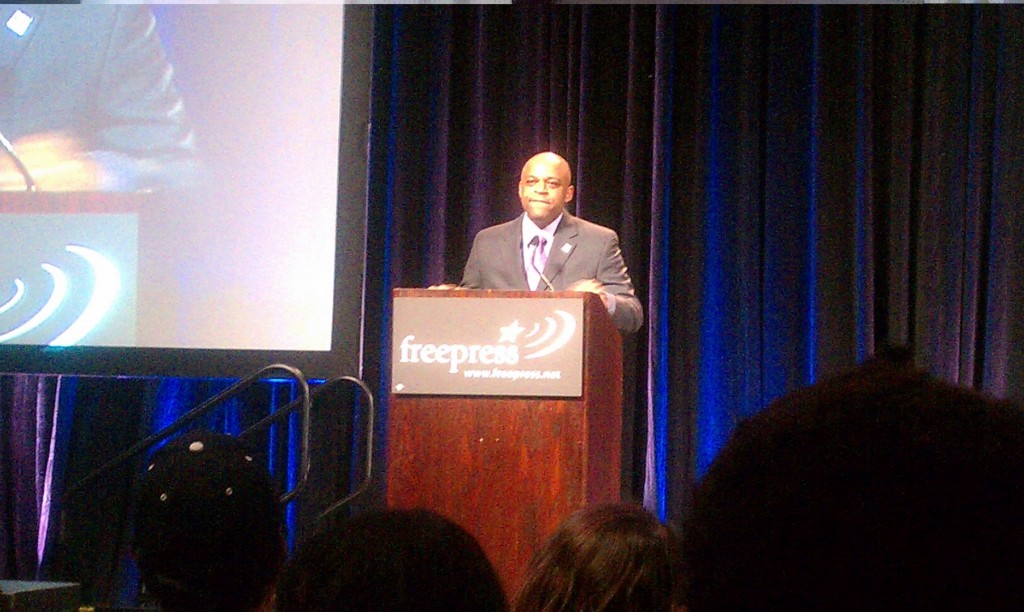

- From left to right: Joseph Torres: Free Press, Juan Gonzalez: Democracy Now! and New York Daily News, Carlotta Walls LaNier: civil rights activist and member of the “Little Rock Nine”, Rinku Sen: Applied Research Center and Colorlines.com
Friday, April 5, 2013 3:20 pm
Tim Hwang from Awesome Foundation for the Arts and Sciences, Mark Stanley from Center for Democracy and Technology, Elizabeth Stark from StartX and Holmes Wilson from Fight for the Future sat on a panel called After SOPA: The New Wave of Internet Activism, moderated by Free Press’s Josh Levy.
The session discussed what the internet freedom movement is doing currently, in the wake of SOPA. The Stop Online Piracy Act, along with the Protect IP Act (PIPA), was indefinitely shelved on Jan. 20, scoring a major win for internet activism.
But many lawmakers still hold misconceptions about the public movement. According to Stark, “The media and folks in D.C. still think this was something organized by Google.”
But the victory hasn’t eliminated legislation that threatens the freedoms of the internet. The Cyber Intelligence Sharing and Protection Act (CISPA) is again being debated in Congress, even after being previously defeated.
According to Stanley, “CISPA allows companies to share information with the government and other companies so they can better stop cyber attacks. CISPA did this in a way that was overly broad and the information will be used for national security purposes that have nothing to do with cyber security.”
The public outcry that shifted the direction of SOPA and PIPA permanently changed the discourse on internet freedom. According to Wilson, SOPA entered the vocabulary of many law-makers. “SOPA means the reaction to the bill. Politicians ask ‘is this SOPA?’ And people are now afraid of ‘getting SOPA-ed,'” Wilson said.
As potent as the threat of “getting SOPA-ed” is right now, there’s a growing fear that someday, politicians might see past the uproar if it isn’t backed with action.
“I fear the moment when politicans go ‘oh, it creates a lot of noise and we take some bad press but it doesn’t really hurt us when it comes to the vote,'” Hwang said.
But changing the way lawmakers think isn’t impossible, and, according to Stanley, doesn’t have to be difficult.
“40-50 calls in one day can make a difference,” Stanley said.
Websites like Collusion can be useful tools in spreading awareness of the ways in which private information is tracked by internet browsing.
Doyouhaveasecret.org was designed to make the notion of government spying and tracking “really creepy,” Wilson said. “That’s the starting point; make it visceral and feel bad.”
CISPAisback.org hosts “a petition, and watches the progress of the bill. We hope to take moments in the progress of the legislation and make a big deal out of those to draw attention,” Holmes said.
The movement against the censorship and heavy-handed regulation of the internet, according to Stark, is one that has been and will continue to be long and strenuous.
“This fight is a marathon,” Stark said, “not a sprint.”
Friday, April 5, 2013 12:10 pm
Among the first sessions on Friday morning was “The Media’s Influence on the Immigration Debate.” Juan Gonzalez of Democracy Now!, Monica Novoa of Define American, Tania A. Unzueta of National Day Laborer Organizing Network and Tania Soto Valenzuela of the Colorado Progressive Coalition sat on the pannel to discuss the ways in which media framing and vocabulary shaped the immigration debate. Aura Bogado of The Nation moderated.
Just this week, the Associated Press changed its policy on the rhetoric describing immigration. The Stylebook no longer sanctions the use of the word “illegal” in reference to an individual.
This change in vocabulary may seem minute in the larger national debate, but as Novoa points out, words can make all the difference.
“The ‘I’ word lends itself to this frame of criminalization. It is not a term that the Board of Immigration Appeals uses and not a term the Supreme Court uses,” Novoa said. “It’s a criminalizing term.”
The issue of criminalization has become incredibly detrimental to the national debate on immigration, and, as Unzueta pointed out, a dangerous way to mislead the American public.
“An aggravated felony might mean a mistemeanor in a criminial court or it could be someone who forged papers to work or drove without a license” Unzueta said. Such rhetoric works to undo the efforts made by immigration activists in humanizing immigrants in the United States.
Gonzalez sees the recent decision by the AP as “a maturing of a debate over who will be an American, who has legitimacy and which new immigration laws will be adopted to reflect the country’s changing nature.”
Gonzalez directly confronted the media have used to frame the immigration debate, specifically the terms “get to the back of the line” with regards to waiting one’s turn when seeking American citizenship and “secure our borders,” referring to the national border between the United States and Mexico.
“Two-thirds of the immigrant problem is with one nation: Mexico,” Gonzalez said. “For Mexicans right now, the line of people waiting to get in is 20 years long–the longest line in the world. Unless you increase the country caps, you are condeming them to wait for 20 years of longer.”
Gonzalez called border security a growing industry that the US government “spent $17.9 billion last year on border security. That’s more than on the FBI, firearms, tobacco and the FDA,” Gonzalez said. “The expenditures are out of control.”
Slowly but surely, the media have recognized the effect of words on the frame of immigration policy, but there’s still a lot of ground to make up, according to the pannel.
As someone who has worked closely with both mass media and undocumented workers, Unzueta has experience with the short-comings of coverage. “Reporters would say ,’Thank you for giving us that undocumented immigrant, now give us an expert,'” Unzueta said. “We just did, how much more expert can you get than someone who spent six months in jail?”
Reactions like this from commercial media outlets made it necessary for activists to take media into their own hands.
Spanish language news outlets moved from exclusively reporting on the struggles of immigrants in the United States to adopting a midset of solidarity, according to Gonzalez.
“In addition to social media of immigrant rights groups, you had this whole new voice that has had a big impact in trying to tell a different story and help to mobilize a population,” Gonzalez said.
The shift in the way the media frames the immigration debate has been in the right direction, but, according to Unzueta, there’s still a long way to go.
“The language is getting pretty,” Unzueta said, “but that doesn’t change my immigration status or that my family can get deported.”
Friday, April 5, 2013 9:21 am
This year’s National Conference on Media Reform is underway at the Sheraton Denver Downtown Hotel. Organized by Free Press, the conference seeks to build a movement across the country to change the way in which media function and call attention to how public policy does and might restrict free speech and media access.
Concurrent sessions will focus on policy and politics, social justice and the fight for media equality, journalism and public media, culture, creators and media makers and internet freedom, technology and innovation. Workshops and media playgrounds will allow conference participants to work on a media project as well as share and hone skills in multimedia outlets.
A virtual soapbox in the middle of the common area gives conference goers the opportunity to have their 15 minutes of fame by giving a speech, singing a song or reading a poem.
The conference also includes live music performances, a bookstore with scheduled opportunities to meet the authors, art galleries and a poet’s corner.
Presenters include Grammy winner and former Moldy Peaches frontwoman Kimya Dawson, producer and co-host of Democracy Now! Amy Goodman, DU’s own Adrienne Russell and mayor Michael Hancock.
The conference will last until Sunday night with nearly 80 sessions and workshops total.

